The four movement of Schubert's "Wanderer" Fantasy are linked by transitions. But the word "transition," as a characterization of the first of these—the passage that links the opening C-Major Allegro to the following  -Minor Adagio—conceals more than it reveals. Toward the end of that Allegro, from m. 143 to m. 166, a grand prolongation of dominant harmony heralds the return of C major, and perhaps even promises a recapitulation of the opening material. The suddenness of the
-Minor Adagio—conceals more than it reveals. Toward the end of that Allegro, from m. 143 to m. 166, a grand prolongation of dominant harmony heralds the return of C major, and perhaps even promises a recapitulation of the opening material. The suddenness of the  diminished seventh chord in measure 167, linked to a
diminished seventh chord in measure 167, linked to a  dominant seventh two measures later, annihilates these expectations. (ex. 1) One comes abruptly upon a different scene, built of the same rhythmic and melodic materials as the preceding ones, but so contrasting in tonality and soon afterwards in texture and tempo that it seems even to contradict those earlier scenes, to make them seem less real in retrospect. The Adagio that begins here does not then so much follow the Allegro as displace it, or at least displace the confirming conclusion for which it has prepared. Accordingly one might hear the arrival of this slow
dominant seventh two measures later, annihilates these expectations. (ex. 1) One comes abruptly upon a different scene, built of the same rhythmic and melodic materials as the preceding ones, but so contrasting in tonality and soon afterwards in texture and tempo that it seems even to contradict those earlier scenes, to make them seem less real in retrospect. The Adagio that begins here does not then so much follow the Allegro as displace it, or at least displace the confirming conclusion for which it has prepared. Accordingly one might hear the arrival of this slow  -minor song as taking the place of a structural downbeat, as a center of gravity, for which the entire opening Allegro has served merely—or so it seems at this moment—as a prolonged upbeat.
-minor song as taking the place of a structural downbeat, as a center of gravity, for which the entire opening Allegro has served merely—or so it seems at this moment—as a prolonged upbeat.
Example 1: Schubert, "Wanderer" Fantasy, D. 760 (op.15), mm. 163-193
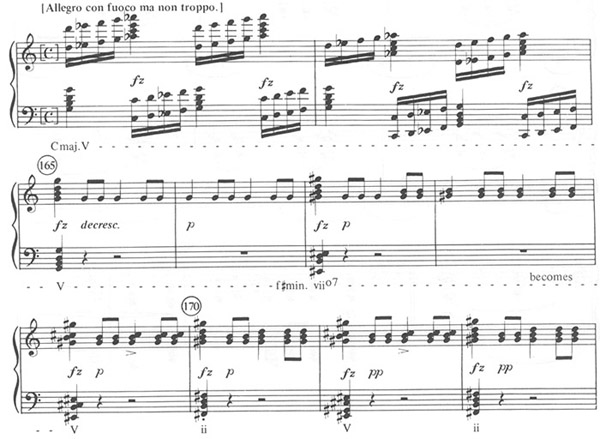
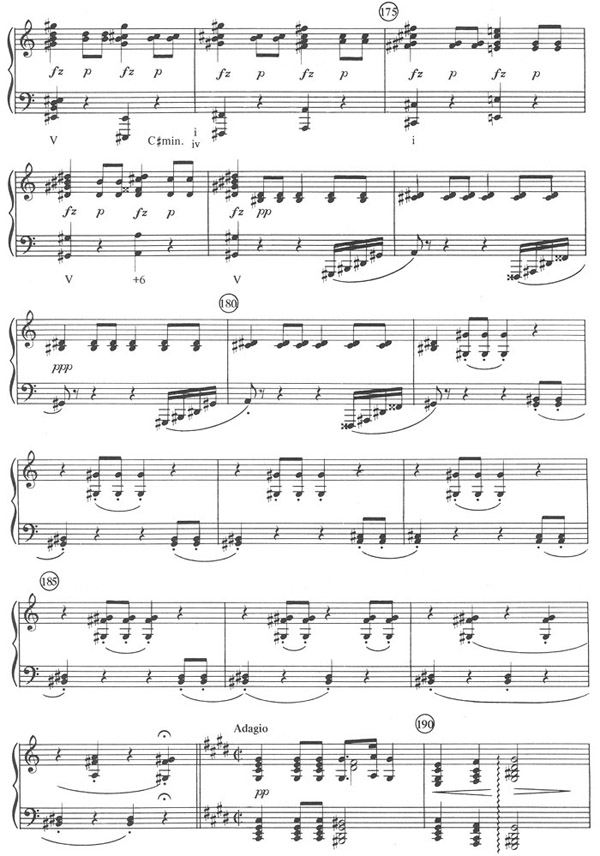

Edward Cone might himself have conceivably applied the term "structural downbeat" to the beginning of the Adagio movement in his Musical Form and Musical Performance. But how might one take up this passage in the language of The Composer's Voice? Cone writes there that for every musical work, "there is a musical persona that is the experiencing subject of the entire composition, in whose thought the play, or narrative, or reverie, takes place—whose inner life the music communicates by means of symbolic gesture." (p. 94) He implies, then, that we hear the different movements of a multi-movement work as different aspects of the experience of a single persona. The various characters or "virtual agents" that one seems to encounter in the course of one or several movements are all encountered, therefore, as they subsist in the perception or imagination of the work's single all-embracing persona. A slow movement will almost always embody very different realms of that experience from an Allegro; and in the "Wanderer" Fantasy, one might say, Schubert underscores an extreme difference of this kind by having the Adagio implode upon the Allegro.
But of course Schubert more than underscores this difference; he makes the awareness of it into a dramatic inner transformation. The transition to the Adagio denies the Allegro its gesturally and tonally prepared ending, and in this way presents the experience embodied in the Adagio as not only different from but in conflict with the experience embodied in the Allegro. The dramatization of this conflict raises the question whether the same persona can authentically experience both. And in its breadth, its "weight," its simpler textures and unambiguouus cadential harmony, the Adagio immediately makes a bid for a superior claim to authenticity. This music at the heart of the Fantasy is also closer than what precedes it to the heart of its persona, a laying bare, to use a stock phrase, of its inner self. According to this description, the persona of the work already identifies itself through two conflicting subordinate personae, one constituted by the opening Allegro, the other by the Adagio. They conflict, rather than merely contrast with or complement one another, because the beginning of the Adagio usurps the paradigmatically prepared scene of the Allegro's conclusion and—if one is willing to accept such a musical semantics—contradicts its tonality. One could relate this musical conflict metaphorically to any number of stereotypes of conflict in different spheres of life: conflicts between public and private selves or personae, between a life of action and a life of contemplation, between the demands of the body and those of the soul, between the epic and the lyric poet, or even between the instrumentalist and the singer in music itself, or, more especially, in Schubert's music.
If one accepts this schema of pers nal1 conflict in the "Wanderer" Fantasy, how does one then construe the way these two subordinate personae, each of them the complete musical persona of a movement left incomplete, interact? Do they relate to each other as equals in combat, as warring halves (or ultimately quarters, since there are four movements) of the complete persona that embraces them? Or does the nature of their interaction imply a hierarchical relation between them?
nal1 conflict in the "Wanderer" Fantasy, how does one then construe the way these two subordinate personae, each of them the complete musical persona of a movement left incomplete, interact? Do they relate to each other as equals in combat, as warring halves (or ultimately quarters, since there are four movements) of the complete persona that embraces them? Or does the nature of their interaction imply a hierarchical relation between them?
In claiming that the Adagio usurps the scene of the Allegro's ending, I am already suggesting its hegemony over the Allegro. But a usurpation reverses hegemony. The Allegro comes first, and—like many first movements—it asserts the motives and the character of the work as a whole, a character that the final movements will re-confirm. The listener therefore provisionally identifies the persona of this Allegro with the persona of the entire work (as happens with the first movements of most large-scale instrumental works), and hears the persona of the Adagio as a subordinate one, but as one that in this case surprisingly takes control.
Already earlier, within the Allegro itself, one can hear certain striking harmonic deflections and changes of texture as disturbances, as effects of an as yet unrevealed cause, or even as doubts of pers nal identity. The first of these comes at the very first cadence, (ex. 2) the irruption into a C-major context of an A-minor semicadence through its own augmented sixth, followed by abrupt silence and the unprepared hushed return of the opening C-major phrases.
nal identity. The first of these comes at the very first cadence, (ex. 2) the irruption into a C-major context of an A-minor semicadence through its own augmented sixth, followed by abrupt silence and the unprepared hushed return of the opening C-major phrases.
Example 2: "Wanderer" Fantasy, mm. 11-20

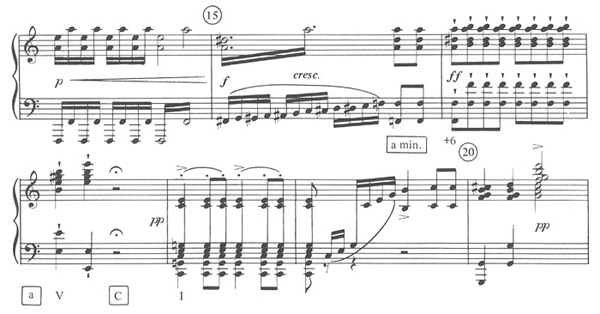
Because it does not resolve, the V of A, an E-major chord, stands out as a quasi-independent sonority. The bridge that follows this return of C major moves predictably to G major; but immediately the E-major sonority, now tonicized, reemerges from two syncopated, quasi-vocal measures of monophony. (ex. 3)
Example 3: "Wanderer" Fantasy, mm. 42-50
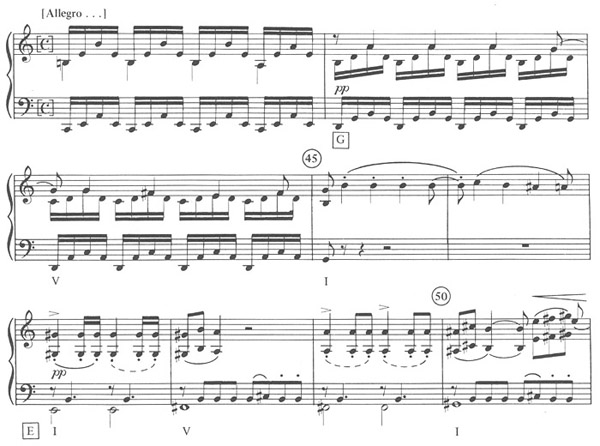
This E-major music, song-like in comparison to what has preceded it, seems to enter the scene "from outside,"2 as if the music's persona had let its mind wander into thoughts of a far away time or place. As E major fades back into C major (mm. 66-67), the question of what psychic force impels this wandering, what traces it follows, remains unanswered. The developmental episode that comes next (mm. 83-107) enters the A-minor territory already envisioned in the Fantasy's first cadence. But this A minor brings neither its own fully articulated cadence nor directed motion into another key. Instead, a dominant seventh of  intrudes upon it, again as if "from outside," and initiates what I shall call a "second developmental episode." (ex. 4) (I might make the claim, but only weakly, that this is an aborted sonata-form movement.)
intrudes upon it, again as if "from outside," and initiates what I shall call a "second developmental episode." (ex. 4) (I might make the claim, but only weakly, that this is an aborted sonata-form movement.)
Example 4: "Wanderer" Fantasy, mm. 103-114
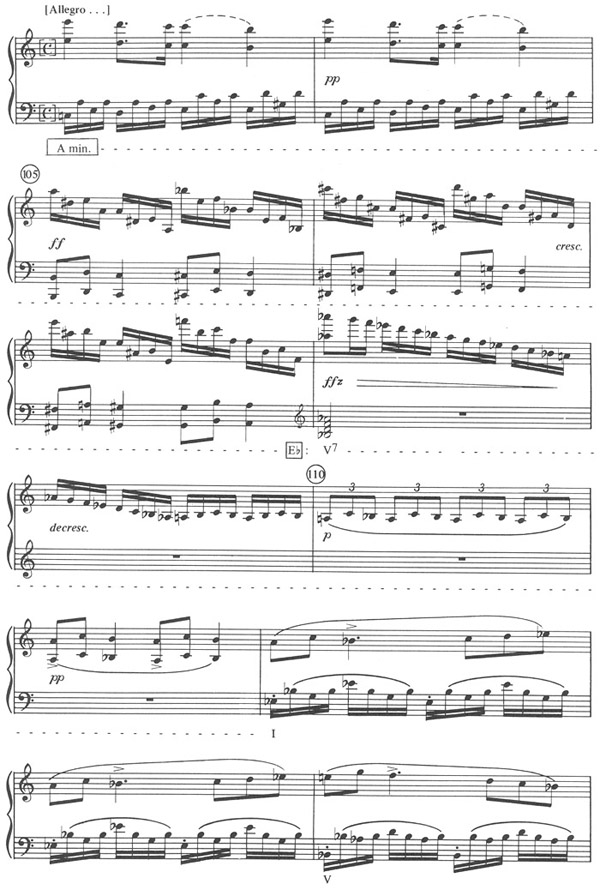
Four esentially monophonic measures within this harmony introduce another new texture, a song with dancing accompaniment. This passage modulates sequentially from  to
to  to heraldic fanfare in
to heraldic fanfare in  , and from there majestically back to the dominant of C.
, and from there majestically back to the dominant of C.
These events sound like disturbances in the first movement because they are both texturally and tonally disjunctive with their surroundings. The main theme's first cadence breaks off abruptly from an E-major chord; the E-major "second theme" and the "second episode" both enter monophonically, quasi-vocally, and both sound relatively songful. The E-major sonority of the cadence and tonality of the "second theme," and then the orderly modulation to  of the "second episode," both sound very foreign to the primary C-major and A-minor tonalities of the movement. But neither E major nor
of the "second episode," both sound very foreign to the primary C-major and A-minor tonalities of the movement. But neither E major nor  major is foreign to the Adagio's
major is foreign to the Adagio's  -
- minor. (A diagram of the entire Fantasy, showing that virtually all its subordinate tonalities can be related to the
minor. (A diagram of the entire Fantasy, showing that virtually all its subordinate tonalities can be related to the  -
- region, is found in fig. 1 below.)
region, is found in fig. 1 below.)
Figure 1: "Wanderer" Fantasy, Diagram of Form and Tonal Areas
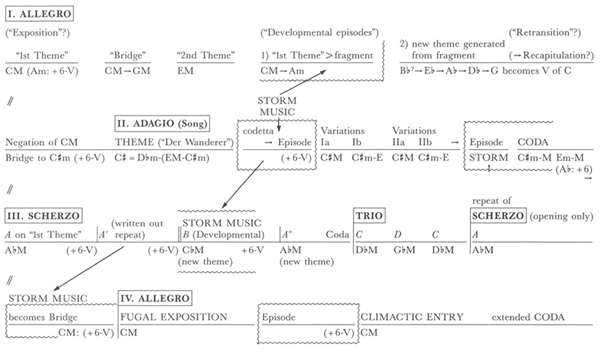
One might say that, though not as yet in consciousness, the persona that the Adagio embodies already operates from a hidden site upon the music of the Allegro, causing that music to wander into a lyricism under its spell. The dramatic arrival of the Adagio, therefore, only makes explicit an already implicit pers nal instability.
nal instability.
It is almost too easy to hear the rest of the Fantasy, its Scherzo and fugal finale, as overcoming that instability. In the Scherzo, with the clarification of that formal paradigm, the subordinate persona re-imagines the first movement, now in  major, a tonality within that persona's own territory or "sphere of influence" (
major, a tonality within that persona's own territory or "sphere of influence" ( being V of
being V of  , the enharmonic equivalent of
, the enharmonic equivalent of  ). The first part of the Scherzo recapitulates the main theme of the first movement, only now cadencing normatively through its own augmented sixth onto its dominant, rather than through those of its relative minor. The "storm music" after the implied double bar (m. 303) recalls the character of the first movement's A-minor "first episode" (m. 83) only to dissolve that frenzy into a
). The first part of the Scherzo recapitulates the main theme of the first movement, only now cadencing normatively through its own augmented sixth onto its dominant, rather than through those of its relative minor. The "storm music" after the implied double bar (m. 303) recalls the character of the first movement's A-minor "first episode" (m. 83) only to dissolve that frenzy into a  -major dance. The trio, in
-major dance. The trio, in  major, recovers the theme of the earlier "second episode" (compare m. 431 with m. 112) in a quiet internalization. Its hushed central phrases in
major, recovers the theme of the earlier "second episode" (compare m. 431 with m. 112) in a quiet internalization. Its hushed central phrases in  major (mm. 474-88) find a moment of serenity in a region that, like the
major (mm. 474-88) find a moment of serenity in a region that, like the  -major dance, lies beyond this work's
-major dance, lies beyond this work's  -
- tonal antipode to C major, and thus outside the scene of the central tonal conflict.
tonal antipode to C major, and thus outside the scene of the central tonal conflict.
After this trio, a recapitulation of the Scherzo begins, but the "storm music" now takes it over, becoming the transition to the finale. This transition, also displacing a conclusion, redresses the imbalance of the transition that earlier introduced the Adagio. There, chords associated with  -
- minor violently displaced the dominant of C major. Here
minor violently displaced the dominant of C major. Here  , the dominant of the
, the dominant of the  -
- region, is swept away into a vortex from which C major triumphantly reemerges in a fugal texture that fuses vocal line with instrumental virtuosity. The last harmony of this transition, the one from which C major reemerges, reinterprets as the augmented sixth of C the same harmony that has earlier served as the V7 of
region, is swept away into a vortex from which C major triumphantly reemerges in a fugal texture that fuses vocal line with instrumental virtuosity. The last harmony of this transition, the one from which C major reemerges, reinterprets as the augmented sixth of C the same harmony that has earlier served as the V7 of  -
- . While partially recalling the distinctive harmonic color of the work's first main cadence (mm. 16-17), this progression reveals that this single sonority can link together—in memory—the two principal but mutually distant tonal regions of the Fantasy. Schubert's favorite musical pun, though operating here at a remove, becomes a key that opens a way between its two mutually quite inaccessible regions.
. While partially recalling the distinctive harmonic color of the work's first main cadence (mm. 16-17), this progression reveals that this single sonority can link together—in memory—the two principal but mutually distant tonal regions of the Fantasy. Schubert's favorite musical pun, though operating here at a remove, becomes a key that opens a way between its two mutually quite inaccessible regions.
In this work Schubert has dramatized what I have called the contradiction of C major and  minor as a contradiction between virtuosic instrumental music and song. Of course almost everyone familiar with the Fantasy knows that Schubert actually based it on one of his songs, part of which becomes the theme of the Adagio. Undoubtedly many have played the Fantasy without ever studying the original song, but for Schubert's own time one can reasonably regard knowledge of the song as part of the Fantasy's reception history. Schubert's contemporaries knew "Der Wanderer," published in 1821 as op. 4, no. 1, almost as well as they knew "Erlkonig," his op. 1. In bringing out this Fantasy, his first major instrumental publication (though preceded by many early instrumental works), as op. 15 in 1823, Schubert might reasonably have expected his public to recognize and even to remember the song. Such remembrance might even have culled images from the text, a veritable garden of Romantic stereotypes of alienation.
minor as a contradiction between virtuosic instrumental music and song. Of course almost everyone familiar with the Fantasy knows that Schubert actually based it on one of his songs, part of which becomes the theme of the Adagio. Undoubtedly many have played the Fantasy without ever studying the original song, but for Schubert's own time one can reasonably regard knowledge of the song as part of the Fantasy's reception history. Schubert's contemporaries knew "Der Wanderer," published in 1821 as op. 4, no. 1, almost as well as they knew "Erlkonig," his op. 1. In bringing out this Fantasy, his first major instrumental publication (though preceded by many early instrumental works), as op. 15 in 1823, Schubert might reasonably have expected his public to recognize and even to remember the song. Such remembrance might even have culled images from the text, a veritable garden of Romantic stereotypes of alienation.
The Adagio melody at the heart of the Fantasy is fundamentally the same  -minor melody that lies at the heart of the song, the third of its six stanzas. (ex. 5)
-minor melody that lies at the heart of the song, the third of its six stanzas. (ex. 5)
Example 5: Schubert, "Der Wanderer," D. 489 (op. 4, no. 1) stanza 3, mm. 23-30
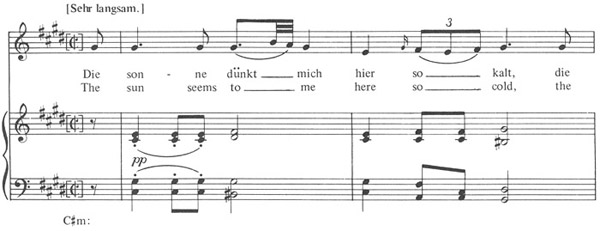
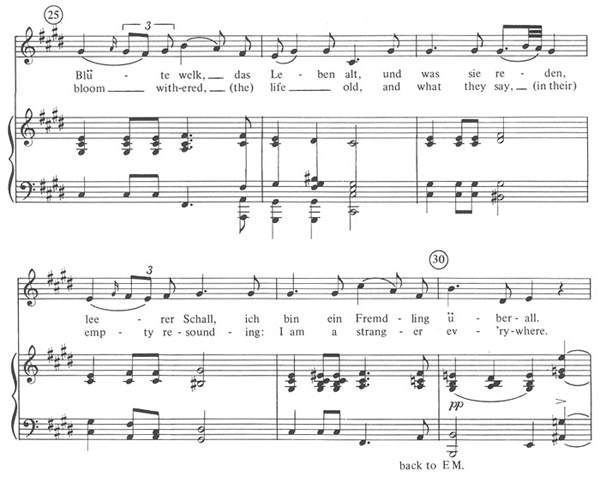
This stanza reaches its melodic high point,  , on its key word, "Fremdling." The
, on its key word, "Fremdling." The  -minor subdominant harmony that supports it becomes immediately "entfremdt" from itself as a pivot chord to the E-major cadence of "überall." Though most of the rest of the song remains in E major—it even ends there—the opening three stanzas have given their weight to
-minor subdominant harmony that supports it becomes immediately "entfremdt" from itself as a pivot chord to the E-major cadence of "überall." Though most of the rest of the song remains in E major—it even ends there—the opening three stanzas have given their weight to  minor, and this key never quite relinquishes its tonal hold over the song. Perhaps the cadence of stanza 2, (ex. 6) a repeated semicadence in
minor, and this key never quite relinquishes its tonal hold over the song. Perhaps the cadence of stanza 2, (ex. 6) a repeated semicadence in  minor buttressed by its augmented sixth, is what establishes this hold so strongly.
minor buttressed by its augmented sixth, is what establishes this hold so strongly.
Example 6: "Der Wanderer," stanza 2, mm. 14-22
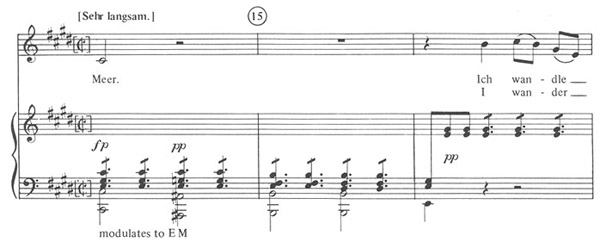
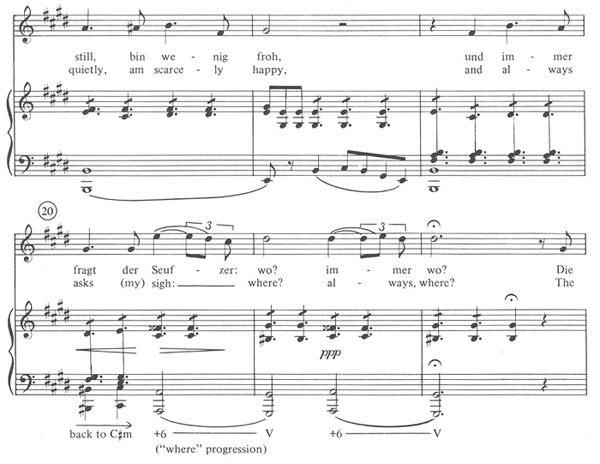
I have already commented on the importance of the same progression in the Fantasy, beginning with its very first cadence (mm. 16-17) and culminating in the return to C major for the finale and in the finale's climaxes. In the song, this second stanza, from which the second phrase group of the Fantasy's Adagio derives, begins in E for "Ich wandle still, bin wenig froh," but draws back into  minor for "und immer fragt der Seufzer: wo, immer wo?" The same words and music return just before the last stanza, disturbing the E major of the two preceding ones, and leaving its unsettling impression on the final return to E.
minor for "und immer fragt der Seufzer: wo, immer wo?" The same words and music return just before the last stanza, disturbing the E major of the two preceding ones, and leaving its unsettling impression on the final return to E.
The words of that conclusion—"dort, wo du nicht bist, dort ist das Glück"—almost demand musical inconclusiveness. E major in this song is the key of wandering, of "überall," of searching and of the hallucination of finding one's true homeland. The song clearly ends in E, but in an E that at first re-emerges ambiguously and then never has time to reconfirm iteself fully. In reality, the song's protagonist is left in  minor, a Fremdling to the E-major world of which he dreams.
minor, a Fremdling to the E-major world of which he dreams.
Compared to the protagonist of the song, the persona of the Fantasy's Adagio first emerges both tonally and gesturally as even more a Fremdling from its surroundings. One might even say that the Fantasy incorprorates the persona of the song—or the kernal of that persona—in a concentrated form, retaining only moments of its E-major dreaming, and intensifying its "Entfremdheit" through the jarring conflict of  minor with C major. But the persona of the Fantasy as a whole confronts this Fremdling, this residual song-persona that it harbors within, in order to overcome its alienation and integrate it within its own world. To accomplish this integration, it must return to and dwell within its memory of the situation of the song-persona: the variations on the Adagio theme exemplify such a dwelling in that scene, a scene now ravaged by violent storms (mm. 206-14 and 231-36), now transfigured in the epiphanic emergences of
minor with C major. But the persona of the Fantasy as a whole confronts this Fremdling, this residual song-persona that it harbors within, in order to overcome its alienation and integrate it within its own world. To accomplish this integration, it must return to and dwell within its memory of the situation of the song-persona: the variations on the Adagio theme exemplify such a dwelling in that scene, a scene now ravaged by violent storms (mm. 206-14 and 231-36), now transfigured in the epiphanic emergences of  major (mm. 215 and 223). The stasis of these variations enacts a "staying with" the lonely, frightenend but also revelatory Fremdling within.
major (mm. 215 and 223). The stasis of these variations enacts a "staying with" the lonely, frightenend but also revelatory Fremdling within.
Undoubltedly the bohemian Schubert felt and continued to feel identified with the Fremdling wanderer of Schmidt von Lübeck's poem, as did so many of his contemporaries. He returned to this theme in both "Die Schöne Müllerin" and "Winterreise"; and one could even argue that he returned to it metaphorically in his later instrumental music, in a way that I shall explain in a moment. Is it too fanciful further to say that in composing the Fantasy, his first completed major instrumental work in three years, he inscribed into the music itself an analogue of his own situation as a composer? He had already found his own authentic voice (to invoke once again a central term of Romantic ideology) through the personae of his early songs, and now he found his way more fully to "authentic" utterance in instrumental music by integrating a residual song, first encountered as a Fremdling to its new instrumental context, into an exaggeratedly instrumental work.
Having achieved such an explicit integration, Schubert rarely resorted again to quoting his own songs in his instrumental music.3 But he retained a way of juxtaposing and texturally highlighting the difference between mutually remote tonal regions that can suggest the presence in his music of conflicting subordinate personae, which is to say, of incompatible experiences within the same consciousness. The unfolding of his large-scale instrumental works often resembles a narrative that eventually makes disparate worlds into one, by forging normative musical continuities from materials that at first occur disjunctively. The music can seem to wander, but it wanders within a tonal cosmos structured through the systematic co-articulation of mutually distant tonal regions. In the "Wanderer" Fantasy, the Fremdling region of  -
- minor exerts an all-pervasive influence over the work's tonality. Where
minor exerts an all-pervasive influence over the work's tonality. Where  -
- is not present as a key, it is present as a force manifested in all the tonal disturbances of a C-major world. The tonal cosmos of the Fantasy, then, is C major under the spell of
is not present as a key, it is present as a force manifested in all the tonal disturbances of a C-major world. The tonal cosmos of the Fantasy, then, is C major under the spell of  -
- minor, the dwelling place of its subordinate persona; a residual song-persona.
minor, the dwelling place of its subordinate persona; a residual song-persona.
1The line over the "o" ( ) is meant to distinguish the adjectival form of "persona," intended here, from the adjectival form of "person."
) is meant to distinguish the adjectival form of "persona," intended here, from the adjectival form of "person."
2See Peter Gülke, "Zum Bild des späten Schubert: vorwiegend analytische Betrachtungen zum Streichquintett, op. 163," in Deutsches Jahrbuch für Musikwissenschaft 18 (1973-77; reprint, Leipzig, 1978): 5-58, especially 8.
3He did so three times: in the Variations on "Trock'ne Blumen" for Flute and Piano (1824), the D-minor String Quartet ("Der Tod und das Mädchen [1824]), and the C-major Fantasy for Violin and Piano ("Sei mir gegrüsst" [1827]).


